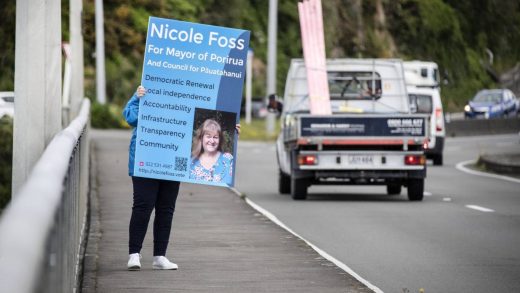
When it comes to vacant and derelict buildings, City of Winnipeg officials, real estate developers and advocates agree the process is overly complex and slow moving.
Policy changes could be on the way, but repeated delays are frustrating for all and potentially hazardous for the community.
“The city would rather have derelict buildings than vacant lots,” said Brennan Ryan, a local developer. “I don’t want buildings to sit empty and potentially burn either, but unless you have a development plan, the process for getting it demolished is (difficult).”
Tyler Searle / Winnipeg Free Press The Regina House apartment building, at 160 Mayfair Ave., remains untouched since it burned in May 2022 because the owner hasn’t finalized a redevelopment plan.
Ryan, 48, and his business partner at Rysco Properties have owned Regina House, a vacant former apartment at 160 Mayfair Ave. for roughly three years.
They had worked for months to secure demolition permits, but repeated processing delays and inadequate redevelopment plans drafted by an architecture firm delayed the process.
On May 28, 2022, the building burned in a fire and was a complete loss. It was the third time the building had caught fire in 11 months.
The final damage was so significant, the Winnipeg Fire Paramedic Service was unable to complete an investigation into what had caused it, a spokesperson said.
Nine months later, what remains is a crumbling wreck surrounded by metal fencing.
Ryan said he wants it gone but, without redevelopment plans, it’s not possible. Before such plans can be approved, the property must be rezoned.
It’s one step after the other in a protracted process.
“I can’t build things until I get that done, so those timelines are horrifically long,” he said. “I don’t think (the city) understands how long it takes to get every piece of the puzzle together. It’s not a deliberate opposition (to developers), its just inefficiency.”
Tyler Searle / Winnipeg Free Press The remains of a vacant apartment at 160 Mayfair Ave. on March 1, 2023. The building burned May 28, 2022, and has been sitting untouched since. The property owner says he wants to tear it down but does not have plans in place to rebuild and wait lists for demolition companies are months long.
Even after a building is demolished, issues can remain.
A massive pile of rubble at 694 Sherbrook St. has plagued the neighbourhood since the former apartment building on the site burned more than a year ago.
According to a report made to council’s property and development committee in January, the Sherbrook site had cost the City of Winnipeg a collective $54,000 to address safety concerns and demolition efforts.
The city had served the property owners with a notice requiring them to remove the debris before Feb. 15, yet still it remains.
During a standard demolition under city rules, the permit applicant or property owner is responsible for removing any debris remaining after a structure is demolished, which is typically required within the permit expiration date.
Access Credit Union, which holds a mortgage on the property but is not the registered owner, has said the delay is due to an insurance dispute.
When asked this week what the city plans to do, a spokesperson said it retains the “legal authority to ensure they addresses any outstanding issues.” However, they refused to comment on how it might enforce the order.
From the perspective of developers, Ryan said, it is sometimes more cost effective to let the rubble remain if they are not ready — or approved — to rebuild.
Tyler Searle / Winnipeg Free Press The pile of rubble at 694 Sherbrook St. has remained an eyesore since the apartment building on the site burned down more than a year ago.
As a solution, he suggested amending current bylaws and expediting the permitting process, allowing developers to demolish buildings without having to immediately rebuild or backfill the building foundation.
To encourage future redevelopment, the city could update its vacant property bylaws to impose more stringent taxes, he said.
For its part, the city is concerned about potentially incentivizing developers to demolish without rebuilding — leaving more vacant properties and reducing tax revenue, said Coun. Matt Allard, who is on the property and development committee.
However, Allard agrees deficiencies in the system need to be addressed.
In December, the property committee asked Winnipeg’s public service to file a report on the vacant and derelict property procedures in the hopes of exploring amendments. The service asked for an extension during a council meeting Thursday, further delaying potential changes.
Regardless of what the report says or when it arrives, the St. Boniface councillor supports both the idea of updating tax rules and editing the demolition process. However, council would have to weigh the risk that might come with leaving unfilled foundations on vacant properties, he said.
“The public safety argument should trump all,” he said by phone Thursday. “I think many property owners would agree to pay a fee in exchange for faster demolition because they don’t have to continue paying insurance (on the building) and it’s cheaper… It’s a win-win-win for developers, the city and the community.”
Sel Burrows, a community activist who advocates for restoring or replacing derelict properties with affordable housing, said financial penalties do little to encourage development or enforce bylaws.
Mike Deal / Winnipeg Free Press files ‘If we want a healthy city, we have to help both tenants and owners to get these places livable,’ says community activist Sel Burrows.
While developers and city officials argue bureaucracy, the community suffers, he said.
“If we want a healthy city, we have to help both tenants and owners to get these places livable.”
Instead, the 79-year-old suggests the city clarify its policies, so both developers and the public understand what is expected of them. He also argues the city should expedite the process by which it seizes vacant properties from owners who default on payments, believing Winnipeg has a large enough stock of vacant homes to address homelessness.
According to a report filed to the property committee on Jan. 26, the city monitored 683 vacant properties in 2021 at a cost of more than $500,000.


